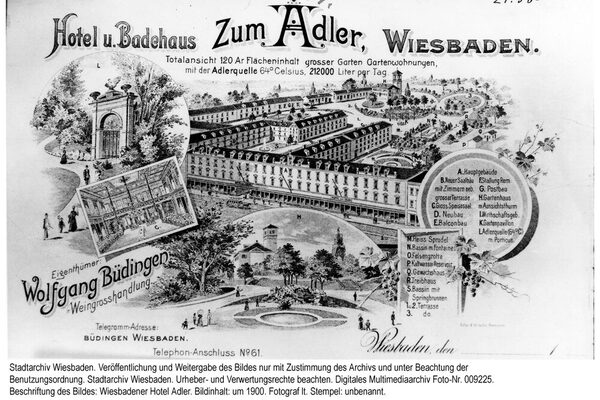Hotel Adler
The Hotel Adler, first mentioned in 1505 under the name "Kannen", whose baths were fed by the Adler spring and which was replaced by a new building at the beginning of the 17th century, was mentioned in 1662 by the Frankfurt physician Ludwig von Hörnigk in the second edition of his description of Wiesbaden as a first-class bathhouse. Eberhard Melchior, personal physician to Georg August Samuel Prince of Nassau-Idstein, reported in 1696 that the Adlerbad had various "princely" baths, sumptuously framed with marble, and that the rooms were also equipped with every comfort.
After changing ownership and tenancy, Johann Peter Schlichter from Bavaria acquired the "Zum güldenen Adler" bathhouse in 1770. Around 1800, his widow had most of the buildings demolished and replaced by a new building in the neoclassical style.
The new Hotel Adler extended over three storeys; its front ran for 60 m along Langgasse. It had 60 well-furnished rooms and 36 bathrooms and experienced its heyday in the first decades of the 19th century. In 1806, the widow Schlichter had the "Blue Hall" built, the largest hall in Wiesbaden until the Gesellschaftshaus was completed in 1810. In 1796, Schlichter acquired the Prince of Thurn and Taxis' driving and letter post as a further line of business. A reformed church was built on the site in 1787-91. After further structural alterations and purchases of additional land, the Adler had 86 guest rooms and 56 baths in 1846.
In 1878, the merchant Wolfgang Büdingen acquired the Hotel Adler and sold it to the town for 1.8 million marks in 1899. A short time later, the hotel complex was demolished together with the Hotel Goldener Brunnen to make way for Coulinstrasse and the Kaiser-Friedrich Therme, which opened in 1913.
Literature
Czysz, Walter: Vom Römerbad zur Weltkurstadt, Geschichte der Wiesbadener heißen Quellen und Bäder, Wiesbaden 2000 (Schriften des Stadtarchivs Wiesbaden 7).
Roth, F. W. E.: Geschichte und historische Topographie der Stadt Wiesbaden im Mittelalter und der Neuzeit, Wiesbaden 1883 [p. 515 f.].
Spiegel, Margit: Wiesbadener Firmenbriefköpfe aus der Kaiserzeit 1871- 1914. Fabrik- und Hotelansichten auf Geschäftsschreiben und Rechnungen. 50 examples with brief company portraits, vol. 1, Wiesbaden 2003 [pp. 18-22].
